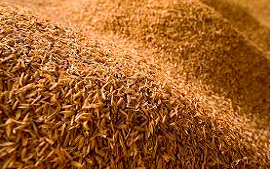REFRACTORY MATERIAL
Applications
- Ladle & Tundish Covering Compound
- EBT Filling Mass
- Exothermic Ladle Bottom Flux
- Almix Powder, Granule and Briquettes
- Nail Chillers
- High MgO EBT Filling Mass / High MgO powder
- Calcium Aluminate – Synthetic Slag & Slag Conditioner
- Burnt Rice Husk Ash (High Silica Value)
- Ceramic Wool
- Unburnt Rice Husk
- Aluminium Wire rolls for slab marking.
- Aluminium Notch Bar
- MS Billets
- Mill Scale
- Direct-reduced Iron (DRI)
- Drill Bits, Drill Rods and Poking Bars
- Nozzle Filling Compound
- Casting Powder
- Calcium Cored Wire
Unburnt Rice Husk
Unburnt Rice Husk
Rice husk is light in weight, yellowish in color and convex in shape, slightly larger than the rice grain. It is separated from the brown rice grain as part of the milling process, after which the rice is polished. Forming one fifth of the volume of paddy, it is bulky and hence difficult to store. Some of its distinctive features include:
- Husk makes for good insulation material since it does not burn easily till air is blown through it. It is highly resistant to the penetration of moisture and fungal decomposition.
- Rice husk decomposes slowly due to the rich silica content, and can therefore not be considered for use as fodder.
- When rice husk is burned, its ash content of 17 – 26 % is far higher than that of wood and coal. This explains the need for much larger volumes of husk when utilized for power generation.
- Its high calorific value makes it a good source of renewable energy.
- Renewable fuel – Rice husk is being increasingly used as biomass that fuels and co-fuels power plants. There are now a large number of power plants in Asia that are completely powered by ground rice husk.
- Insulation- Rice husk is considered to be a top class insulating material since it is difficult to burn and does not easily absorb moisture. It can be used as insulation powder in steel mills.

